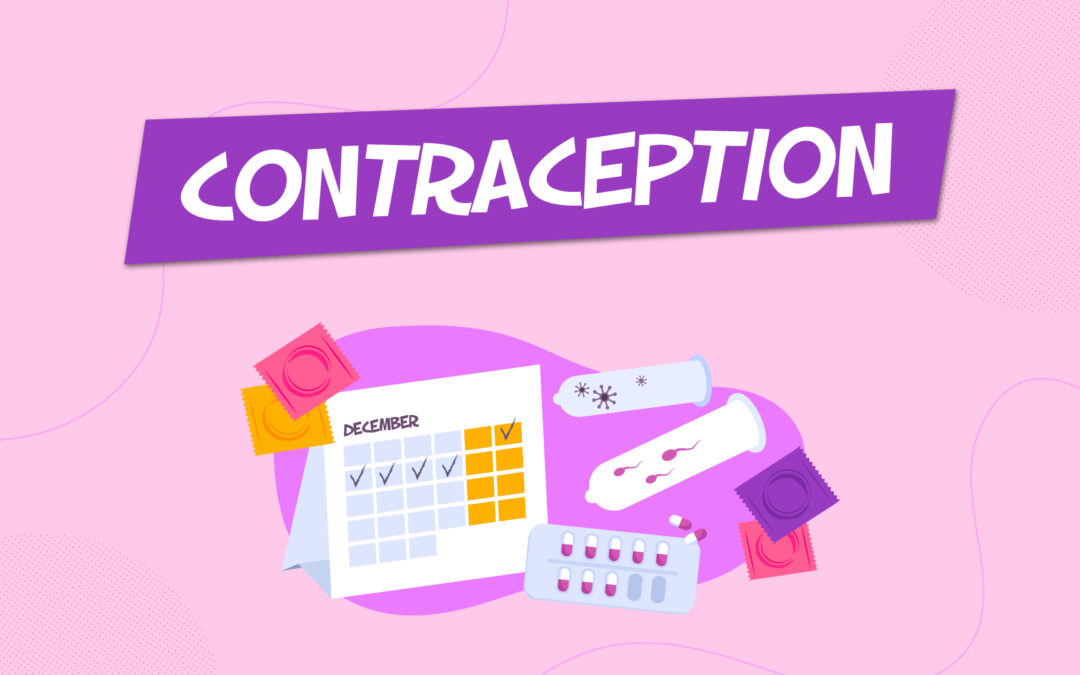Contraceptions are methodology used that prevents pregnancy by interfering with the normal process of ovulation, fertilization, and implantation. Contraceptives are vital tools that enable individuals and couples to take control of their reproductive health and make informed decisions about family planning.
There are different methods of Contraceptives
- Hormonal contraceptives
- Periodic abstinence.
- Emergency Contraceptives.
- Permanent Contraceptives.
- Intrauterine Devices.
- Mechanical Barriers.
Hormonal contraceptives.
They consist of one or more synthetic female sex hormones.
Hormonal contraceptives that contain both an estrogen and progestin are called combined oral contraceptives (COCs). They prevent pregnancy by inhibiting the normal process of ovulation (the release of an egg from an ovary) and altering the lining of the uterus (the endometrium) so that it is unable to support a fertilized egg. They also change the viscosity (stickiness) of mucus within the cervix to make it hard for sperm to travel to the uterus.
Those that contain just progestin are called progestin-only contraceptives (POPs). POPs mainly change the viscosity of mucus and thin the endometrium; in some women, they may also prevent ovulation.
Hormonal contraceptives are available as pills (oral contraceptives), injections, implants.
Periodic Abstinence.
This includes Lactational Amenorrhea (the probability of pregnancy is very low during breastfeeding), Coitus interruptus or withdrawal method (withdrawal of the male reproductive organ before ejaculation) and Natural Family Planning.
Natural Family Planning is the most widely acceptable method of contraceptives especially in religious settings where drugs and other method may be frowned against.
This involves the calendar method, sex is avoided during the fertile window of the woman. This method is more efficient if the woman has a regular and predictable menstrual cycle.
The earliest day of the fertile period is determined by the number of days in the shortest menstrual cycle subtracted by 18. The latest day of the fertile period is calculated by the number of days in the longest cycle subtracted by 11.
Emergency contraceptives
They are taken (or inserted if a copper IUD is used) within a few days after unprotected sex to help prevent implantation of a fertilized egg and a possible resulting pregnancy. Condoms are contraceptives that offer the most protection against sexually transmitted infections, although protection is not 100% guaranteed.
Mechanical Barriers.
This involves the use of Condoms (male and female), diaphragms, cervical Caps and Spermicidal agents.
Permanent Contraceptives
They have a 99.9% success rate and usually involves surgical interventions which include Bilateral ligation of fallopian tube for the women and Vasectomy for the men.
Here are some common contraceptive and their applications:
| Type | Explanation |
| Diaphragm with spermicide
· Silicone (Caya)
|
Flexible dome-shaped cup that is inserted before sex |
| Hormonal contraceptive patch
· Ethinyl estradiol + norelgestromin (Xulane)
|
One patch is applied each week for every three weeks, then usually followed by a patch-free week |
| Hormonal contraceptive rings
· Ethinyl estradiol + etonogestrel (NuvaRing)
|
One ring is inserted into the vagina and remains in place continuously for three weeks, then removed for a one week break before a new ring is inserted |
| Intrauterine devices (IUD)
· Copper (Paragard) · Levonorgestrel (Kyleena, Liletta, Mirena, Skyla)
|
Small, T-shaped device that is inserted through the vagina into the uterus to prevent implantation of a fertilized egg. Lasts 3 to 10 years depending on the type |
| Implantable rods
· etonogestrel (Nexplanon)
|
Small rod the size of a matchstick that is implanted under the skin of the upper arm. Lasts up to 3 years |
| Female condom
· Synthetic latex (FC2)
|
Must be used every time that sex occurs. Provide some protection against STIs |
| Male condom
· Latex · Polyurethane · Polyisoprene |
Must be used every time that sex occurs. Provide some protection against STIs |
| Shot/injection
· Depo-SubQ Provera 104 |
Given by injection under the skin once every 3 months (12 to 14 weeks). |
| Cervical cap with spermicide
· Silicone (FemCap)
|
Soft silicone Cup that covers the cervix and is inserted before sex. May cause irritation, and allergic reactions, and increase the risk of an abnormal Pap test |
| Sponge with spermicide
· Today sponge
|
Soft polyurethane sponge that is inserted before sex and kept in place for six hours after sex |
| Spermicide alone | Must be used every time that sex occurs. Not very reliable. May cause irritation, and allergic reactions, and increase the risk of STIs and UTIs |
Hormonal contraceptives are usually not suitable for all women, especially women with certain types of cancer, liver disease, severe headaches, undiagnosed vaginal bleeding, uncontrolled high blood pressure or heart disease. Non-hormonal methods of contraception may be more suitable for these women. Pregnant women who wish to protect themselves from sexually transmitted infections may use barrier methods of contraception (such as condoms).
Hormonal contraceptives have different side effects such as acne, appetite changes, breast tenderness, enlargement or discharge, changes to menstrual flow, bleeding or spotting between periods, painful or missed periods, constipation or diarrhea, gingivitis (inflammation of the gums), hair growth in unusual places, mood changes, nausea, skin color changes (brown or black patches), stomach cramps or bloating, weight gain or loss, vaginal burning, discharge, irritation, itching, redness, or swelling, vomiting.
Non-hormonal contraceptives may be associated with irritation, itching, redness, or discomfort during sex.
Other uses of Contraceptives
Contraceptives are mostly used to help prevent women from becoming pregnant but some hormonal contraceptives may be prescribed to:
- Help with acne control.
- Help regulate periods.
- Prevent ovulation and pregnancy in women with primary ovarian insufficiency (POI)
- Reduce pain and cramping during menstruation.
- Reduce the symptoms of endometriosis, polycystic ovary syndrome (PCOS), premenstrual syndrome or premenstrual dysphoric disorder (PMDD).
By understanding the different types of contraceptives, considering relevant factors, and seeking guidance from healthcare providers, individuals can choose a suitable method that aligns with their needs, preferences, and goals. With comprehensive education and access to contraceptives, we can promote responsible family planning, reduce unintended pregnancies, and enhance overall reproductive health. However, it is essential to consult healthcare providers who can provide personalized guidance based on an individual’s unique circumstances and medical history.
References
- Contraception | definition of contraception by Medical dictionary. https://medical-dictionary.thefreedictionary.com/contraception.
- Family Planning: A Global Handbook for Providers. 2018 World Health Organization and Johns Hopkins Bloomberg School of Public Health. https://apps.who.int/iris/bitstream/handle/10665/260156/9780999203705-eng.pdf?sequence=1
- Kantorová V, Wheldon MC, Ueffing P, Dasgupta ANZ (2020) Estimating progress towards meeting women’s contraceptive needs in 185 countries: A Bayesian hierarchical modelling study. PLoS Med 17(2):e1003026. https://journals.plos.org/plosmedicine/article?id=10.1371/journal.pmed.1003026
- List of Contraceptives + Types & Side Effects – Drugs.com. https://www.drugs.com/drug-class/contraceptives.html.
- United Nations, Department of Economic and Social Affairs, Population Division. Family Planning and the 2030 Agenda for Sustainable Development. New York: United Nations. https://www.un.org/en/development/desa/population/publications/pdf/family/familyPlanning_DataBooklet_2019.pdf

